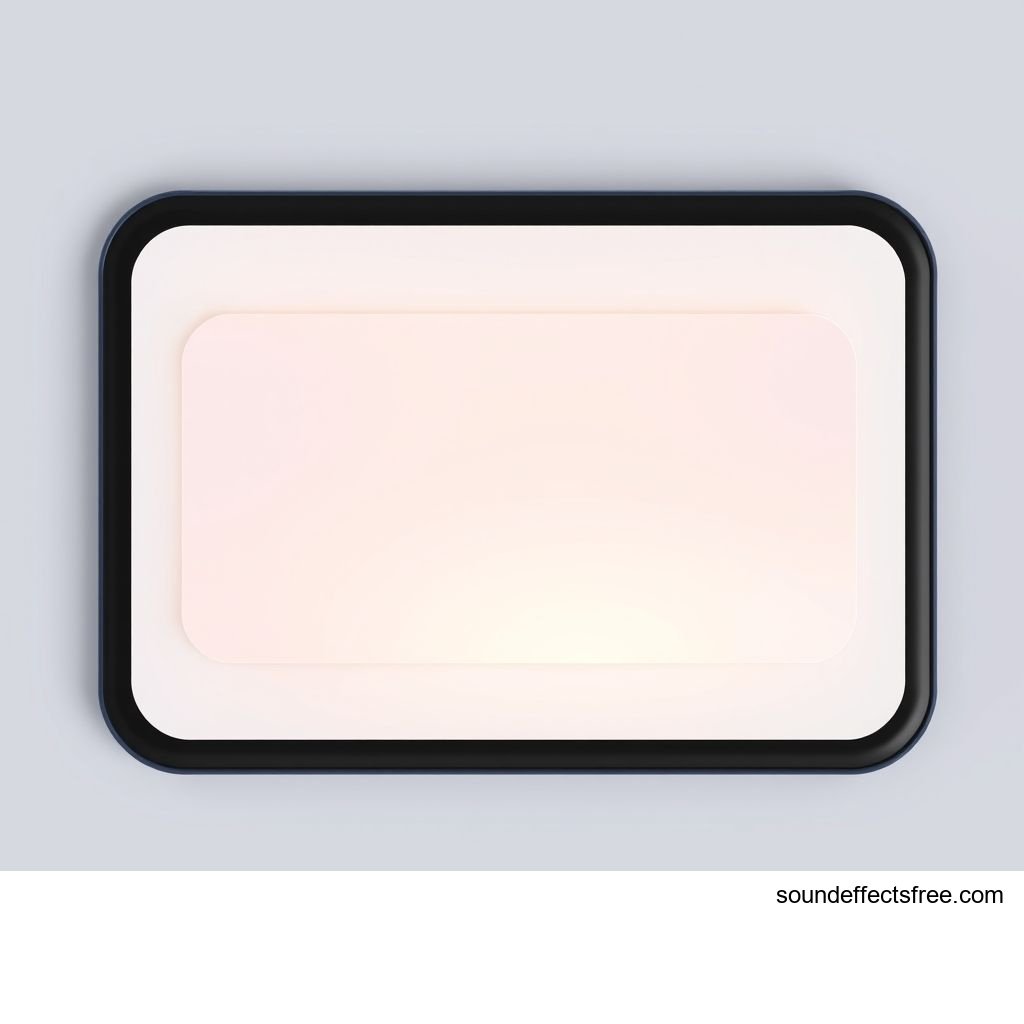Interface Tap Glimmer: Enhancing User Experience with UI Sounds
The modern digital world relies heavily on the humble UI tap. This small audio cue significantly enhances user experience. A well-designed UI tap provides instant, intuitive feedback. It signals successful interaction. It can be a simple digital click or a complex interface feedback sound. This subtle shimmer adds a layer of polish to any application.
A perfect UI tap creates an immediate connection. It makes digital interactions feel more tangible. Users instinctively understand its meaning. This sound can range from a crisp digital click to a soft, ethereal chime. The goal is always clear: confirm user input.
Applications in Media
UI tap sounds are ubiquitous. They appear in countless digital environments. They guide users smoothly through interactions. From mobile apps to complex software, the UI tap is essential. It prevents confusion. It confirms actions.
Industry-Specific Uses
In mobile apps, a distinct UI tap marks every button press. This includes navigation, form submission, and menu select options. Gaming relies heavily on responsive audio. A good UI tap confirms weapon fire, item collection, or character movement. Smart devices also use UI tap sounds. They confirm voice commands or display touches. Web interfaces benefit too. A UI tap can highlight successful form submissions. It signals a new page load. This interface feedback is crucial across all platforms. It makes user journeys seamless. Each UI tap adds to the overall usability.
Creative Techniques
Designers use various creative techniques. They shape the perfect UI tap. Context is key. A confirmation UI tap might be soft. An error UI tap could be more abrupt. Layering subtle shimmer elements adds depth. This makes the UI tap feel richer. It creates a memorable experience. The sound can reflect brand identity. A premium app might use a crisp, clean digital click. A playful app might use a bouncy UI tap. Understanding the user journey helps define the right sound. This careful choice enhances overall interface feedback.
Technical Analysis
Understanding the technical aspects of a UI tap is vital. It allows for precise sound design. Every component influences the final user perception. A good UI tap is meticulously crafted.
Waveform Characteristics
A typical UI tap waveform is very short. It features a quick attack and decay. This transient nature ensures immediate feedback. The sound starts and ends quickly. This prevents auditory clutter. The waveform often shows a sharp initial peak. This represents the "click" or "tap" moment. Following this, the energy quickly dissipates. A clean, concise waveform defines a great UI tap. It should not linger too long. Overlapping sounds can confuse users. Therefore, brevity is key for any UI tap. The precise shape affects the perceived crispness. A tighter waveform means a snappier digital click.
Frequency Profile
The frequency profile of a UI tap is also critical. Most effective UI tap sounds have strong high-frequency content. This gives them a clear, crisp quality. It helps them cut through other ambient sounds. Lower frequencies are often minimized. This prevents the UI tap from sounding muddy or boomy. A distinct high-frequency peak provides a sense of precision. It helps the sound register quickly in the user's ear. Sometimes a subtle shimmer is added. This can come from high-frequency harmonics or a small reverberation tail. This high-end sparkle makes the UI tap feel polished. It creates a satisfying interface feedback.
Production Tips
Creating high-quality UI tap sounds requires skill. It involves careful recording and precise editing. Specialized software tools can further refine these audio assets. These tips help ensure your UI tap sounds professional.
Recording & Editing
Start by recording various real-world sounds. Think about clicks, taps, and light percussive elements. Everyday objects can yield unique UI tap sounds. Experiment with different microphones. Small diaphragm condensers are often excellent. They capture transients well. After recording, careful editing is crucial. Trim dead air aggressively. Remove any unwanted noise. Normalize the audio to a consistent level. Apply gentle compression to control dynamics. Use subtle EQ to shape the frequency profile. Boost high-end for crispness. Cut harsh mid-range frequencies. Each UI tap should be clean. It should be consistent. Consider batch processing for uniformity. This ensures every UI tap adheres to your standards.
Software Tools
Digital Audio Workstations (DAWs) are indispensable. Programs like Ableton Live, Logic Pro, or Pro Tools are ideal. They offer comprehensive editing features. Specialized sound design tools also exist. Samplers can layer multiple UI tap components. Synthesisers can generate unique digital click sounds. Plugins are essential for refinement. Equalizers, compressors, and reverbs are commonly used. Transient shapers can enhance the attack of a UI tap. High-quality software allows for meticulous detail. It ensures every UI tap delivers perfect interface feedback. VST instruments can create a range of synthetic UI tap tones.
Creative Implementation
Beyond basic production, creative implementation elevates a UI tap. Think about how sounds interact. Consider their placement in a virtual space.
Layering Methods
Layering adds depth and complexity to a UI tap. Combine a crisp digital click with a soft, underlying tone. This creates a richer sound. You might layer a short transient with a subtle shimmer. This adds character. Consider using multiple textures. A metallic tap can be combined with a subtle woody knock. This creates a unique UI tap signature. Ensure that layers blend well. Avoid muddying the sound. Each layer should contribute without overwhelming. Proper mixing and volume balance are key. This approach gives you greater control. It makes your UI tap stand out. The layered approach offers flexible interface feedback options.
Spatial Effects
Spatial effects enhance the realism of a UI tap. Reverb can simulate different environments. A short, tight reverb suggests a small, contained space. Longer reverbs can hint at open, airy interfaces. Delay can create a sense of movement. Stereo panning places the UI tap left or right. This can guide the user's attention. Imagine a menu select sound that sweeps across the screen. This makes the interface feel more dynamic. Subtle modulation can add character. It makes the UI tap feel less static. Overuse of spatial effects can be distracting. Use them sparingly for maximum impact. A little goes a long way with a UI tap.
Sound Pack Integration
Integrating a UI tap from a sound pack is efficient. It ensures consistency and quality across your project. These packs provide ready-to-use audio assets.
Using with Other Sounds
A single UI tap rarely stands alone. It must blend seamlessly with other interface sounds. Consider the overall sonic palette of your application. Does the UI tap complement other notification sounds? Does it work well with background music? Ensure volume levels are balanced. The UI tap should be audible but not intrusive. It should provide clear interface feedback. Think about the overall user flow. A distinct UI tap for a menu select should differ from a simple button press. Harmony between sounds is crucial. This creates a cohesive audio experience.
Complete Collection
Related UI tap sounds offer a broader range of options. For comprehensive audio solutions, consider a full sound pack. These collections provide a consistent style. They include various UI tap sounds. You will find different digital click variations. Many offer unique subtle shimmer effects. They cover every menu select need. UI Confirm Tap is just one example. Discover high-quality sound effects from Pro Sound Effects.
Get the full sound pack for comprehensive audio solutions.
Frequently Asked Questions (FAQ)
What is a UI tap sound?
A UI tap sound is a brief audio cue. It confirms a user's interaction with a digital interface. It provides immediate interface feedback.
Why is UI tap sound important for user experience?
A UI tap provides crucial auditory feedback. It makes digital interactions feel more responsive and tangible. It reduces user uncertainty.
How can I make my digital click sound more professional?
To make a digital click more professional, focus on crispness and brevity. Use high-quality recordings. Apply precise editing, EQ, and gentle compression.
What's the difference between a subtle shimmer and a standard UI tap?
A subtle shimmer often refers to a lighter, more ethereal quality added to a UI tap. It uses high frequencies or light reverb. A standard UI tap is generally a more direct, simple digital click sound.
Can I use a single UI tap sound for all menu select actions?
While possible, using a single UI tap for all menu select actions might be monotonous. Varying sounds slightly can differentiate actions. This provides clearer interface feedback.





